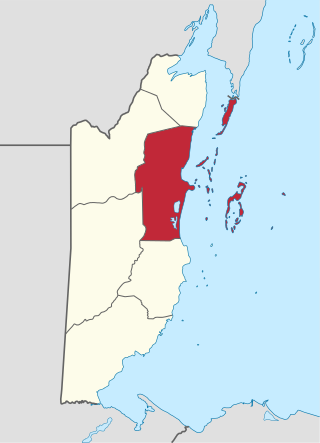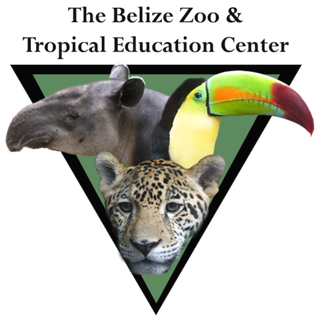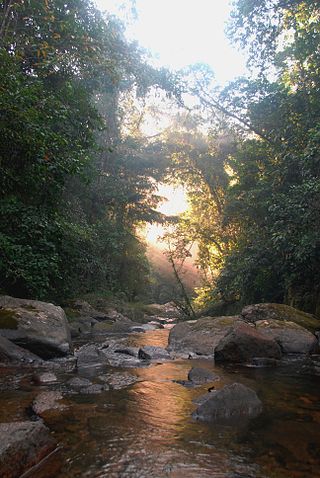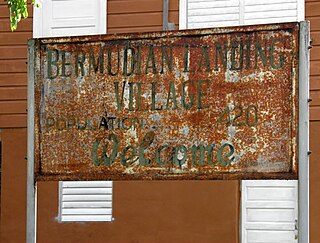
Toledo District is the southernmost and least populated district in Belize. Punta Gorda is the District capital. According to the Human Development Index (HDI), it is the second most developed region in the country. The district has a diverse topography which features rainforests, extensive cave networks, coastal lowland plains, and offshore cays. Toledo is home to a wide range of cultures such as Mopan, Kekchi Maya, Creole, Garifuna, East Indians, Mennonites, Mestizos, and descendants of US Confederate settlers.

Belize District is a district of the nation of Belize. Its capital is Belize City.

The harpy eagle is a neotropical species of eagle. It is also called the American harpy eagle to distinguish it from the Papuan eagle, which is sometimes known as the New Guinea harpy eagle or Papuan harpy eagle. It is the largest and most powerful bird of prey found throughout its range, and among the largest extant species of eagles in the world. It usually inhabits tropical lowland rainforests in the upper (emergent) canopy layer. Destruction of its natural habitat has caused it to vanish from many parts of its former range, and it is nearly extirpated from much of Central America. In Brazil, the harpy eagle is also known as royal-hawk. The genus Harpia, together with Harpyopsis and Morphnus, form the subfamily Harpiinae.

The Yucatán black howler, or Guatemalan black howler, is a species of howler monkey, a type of New World monkey, from Central America. It is found in Belize, Guatemala and Mexico, in and near the Yucatán Peninsula. It lives in evergreen, semideciduous and lowland rain forests. It is also known as the baboon in Belize, although it is not closely related to the baboons in Africa.

Monkey Jungle is a 30-acre (12 ha) zoological park located in South Miami, Florida. Established in 1933 by Joseph DuMond for the exhibition and study of endangered monkeys in semi-natural habitats after releasing 6 Java Macaques into a subtropical forest, the park is now home to over 300 primates.

Monkey River is a coastal watercourse in southern Belize that rises in the Maya Mountains and discharges to the Caribbean Sea near Monkey River Town. One of Belize's major rivers, Monkey River has northern headwaters which originate in the Cockscomb Basin Wildlife Sanctuary, where the Swasey Branch drains the East Basin of that wildlife sanctuary. Further south, the Bladen Branch watercourse drains the eastern slopes of the Maya Mountains including the ancient Mayan settlement areas of Lubaantun and Nim Li Punit. These two watercourses join to form the Monkey River approximately 16 kilometres upstream from the mouth of the Monkey River. The Monkey River is readily navigated throughout the year using small boats, but navigation above the major confluence becomes more difficult due to lack of depth when the dry season starts about February. Habitats in this watershed provide cover for such diverse species as the ocelot, jaguar, Guatemalan black howler, bare-throated tiger heron, Morelet's crocodile, fer-de-lance and manatee.

Cousins is a nature documentary TV series produced by the BBC Natural History Unit in Bristol, England, first transmitted in the UK on BBC One in August 2000. The series looks at the primates, the closest living relatives to human beings.
The Maderas Rainforest Conservancy is a nonprofit organization which was established to promote the conservation, protection, and management of Mesoamerican forests and animal and plant biodiversity through education, reforestation, preservation, and by working with local communities, and national and international institutions and universities.

The Belize Zoo and Tropical Education Center is a zoo in Belize, located some 47 kilometres (29 mi) west of Belize City on the Western Highway. Set in 12 hectares, the zoo was founded in 1983 by Sharon Matola. It is home to more than 175 animals of about 48 species, all native to Belize. The natural environment of Belize is left entirely intact within the zoo. The dense, natural vegetation is separated only by gravel trails through the forest. The Belize Zoo and Tropical Education Center receives over 68,000 visitors annually, with 15,000 being students, teachers, and parents.
Crooked Tree Wild Life Sanctuary (CTWS) is a protected area in Belize. It is recognized as a Wetland of International Importance. It was designated as a waterfowl habitat on April 22, 1998, under the Ramsar Convention on Wetlands. During Belize's dry season many resident and migratory birds find refuge in the lagoons. The sanctuary contains 16,400 acres (6,600 ha) of lagoons, creeks, log wood swamps, broad leaf forest and pine savanna, home to hundreds of species of wildlife. The sanctuary protects globally endangered species including the Central American river turtle (locally known as hicatee), Mexican black howler monkey, and yellow-headed parrot.

Bladen Nature Reserve in Belize is a landscape of caves, sinkholes, streams and rivers, old growth rainforest and an abundance of highly diverse flora and fauna which includes a great deal of rare and endemic species.
Burrell Boom is on the Belize River twenty miles above Belize City, Belize. Tourists pass through this historic village on their way to the Community Baboon Sanctuary, where the population of black howler monkeys has grown to over 2,000.

Bermudian Landing is a village in the nation of Belize, located near Scotland Halfmoon in Belize District. The name comes from the Bermuda grass planted by the early loggers to feed their oxen, who were used to drag the mahogany to the landing.
Saint Paul's Bank is a populated settlement located in the nation of Belize. It is a mainland village that is located in Belize District and one of seven villages across 18 - square miles of the Belize River Valley that make up the Community Baboon Sanctuary: Big Falls, St. Paul's Bank, Willow's Bank, Double Head Cabbage, Bermudian Landing, Isabella Bank and Flower's Bank. This village lies along a road which ends at the Belize River, and is well known for the “big falls” on the river. In the dry season these “falls” are large rock outcroppings, creating the largest rapids on the Belize River. These rapids are part of the route of La Ruta Maya, a 4-day canoe race on the Belize River.
Tapir Mountain Nature Reserve is a protected area in Belize, Central America. It falls under category (Ia) of the International Union for Conservation of Nature protected areas categories. It is managed by the Belize Forest Department and co-managed by the Belize Karst Habitat Conservation.

Shipstern Conservation and Management Area is a protected area located in the Corozal District of northeastern Belize.
The Aguacaliente Wildlife Sanctuary is a nature reserve in the Toledo District of southern Belize. It encompasses approximately 5,492 acres (22.23 km2) and was declared a sanctuary in 1998. The Sanctuary is critical for the preservation of biodiversity in Belize and the region. The National Park protects the central wetlands areas which consist of three fresh water lagoons and a hot-spring connected by a number of creeks hence the name Aguacaliente. It is co-managed by the Aguacaliente Management Team (AMT), a consortium of people from adjacent villages.
The Gales Point Wildlife Sanctuary is in the Belize District approximately 23.7 southwest of Belize City and 34 km north of Dangriga. The Sanctuary includes Southern Lagoon, Sapodilla Lagoon, Western Lagoon, Quashie Trap Lagoon and a portion of the Manatee river. It has a shoreline of 66-foot that is along all the lagoons and waterways except for the peninsula. The Wildlife Sanctuary covers a complex matrix of creeks, mangroves, mudflats and brackish lagoons. Both the rivers and creeks drains into the lagoon from the west. The lagoon is also connected to the Caribbean Sea via the Bar River.











